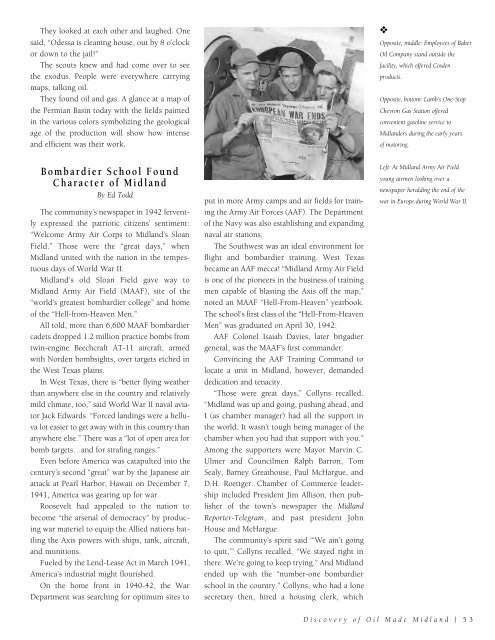Historic Midland
An illustrated history of the Midland County area, paired with the histories of companies, families and organizations that make the region great.
An illustrated history of the Midland County area, paired with the histories of companies, families and organizations that make the region great.
You also want an ePaper? Increase the reach of your titles
YUMPU automatically turns print PDFs into web optimized ePapers that Google loves.
They looked at each other and laughed. One<br />
said, “Odessa is cleaning house, out by 8 o’clock<br />
or down to the jail!”<br />
The scouts knew and had come over to see<br />
the exodus. People were everywhere carrying<br />
maps, talking oil.<br />
They found oil and gas. A glance at a map of<br />
the Permian Basin today with the fields painted<br />
in the various colors symbolizing the geological<br />
age of the production will show how intense<br />
and efficient was their work.<br />
❖<br />
Opposite, middle: Employees of Baker<br />
Oil Company stand outside the<br />
facility, which offered Cosden<br />
products.<br />
Opposite, bottom: Lamb’s One-Stop<br />
Chevron Gas Station offered<br />
convenient gasoline service to<br />
<strong>Midland</strong>ers during the early years<br />
of motoring.<br />
Bombardier School Found<br />
Character of <strong>Midland</strong><br />
By Ed Todd<br />
The community’s newspaper in 1942 fervently<br />
expressed the patriotic citizens’ sentiment:<br />
“Welcome Army Air Corps to <strong>Midland</strong>’s Sloan<br />
Field.” Those were the “great days,” when<br />
<strong>Midland</strong> united with the nation in the tempestuous<br />
days of World War II.<br />
<strong>Midland</strong>’s old Sloan Field gave way to<br />
<strong>Midland</strong> Army Air Field (MAAF), site of the<br />
“world’s greatest bombardier college” and home<br />
of the “Hell-from-Heaven Men.”<br />
All told, more than 6,600 MAAF bombardier<br />
cadets dropped 1.2 million practice bombs from<br />
twin-engine Beechcraft AT-11 aircraft, armed<br />
with Norden bombsights, over targets etched in<br />
the West Texas plains.<br />
In West Texas, there is “better flying weather<br />
than anywhere else in the country and relatively<br />
mild climate, too,” said World War II naval aviator<br />
Jack Edwards. “Forced landings were a helluva<br />
lot easier to get away with in this country than<br />
anywhere else.” There was a “lot of open area for<br />
bomb targets…and for strafing ranges.”<br />
Even before America was catapulted into the<br />
century’s second “great” war by the Japanese air<br />
attack at Pearl Harbor, Hawaii on December 7,<br />
1941, America was gearing up for war.<br />
Roosevelt had appealed to the nation to<br />
become “the arsenal of democracy” by producing<br />
war materiel to equip the Allied nations battling<br />
the Axis powers with ships, tank, aircraft,<br />
and munitions.<br />
Fueled by the Lend-Lease Act in March 1941,<br />
America’s industrial might flourished.<br />
On the home front in 1940-42, the War<br />
Department was searching for optimum sites to<br />
put in more Army camps and air fields for training<br />
the Army Air Forces (AAF). The Department<br />
of the Navy was also establishing and expanding<br />
naval air stations.<br />
The Southwest was an ideal environment for<br />
flight and bombardier training. West Texas<br />
became an AAF mecca! “<strong>Midland</strong> Army Air Field<br />
is one of the pioneers in the business of training<br />
men capable of blasting the Axis off the map,”<br />
noted an MAAF “Hell-From-Heaven” yearbook.<br />
The school’s first class of the “Hell-From-Heaven<br />
Men” was graduated on April 30, 1942.<br />
AAF Colonel Isaiah Davies, later brigadier<br />
general, was the MAAF’s first commander.<br />
Convincing the AAF Training Command to<br />
locate a unit in <strong>Midland</strong>, however, demanded<br />
dedication and tenacity.<br />
“Those were great days,” Collyns recalled.<br />
“<strong>Midland</strong> was up and going, pushing ahead, and<br />
I (as chamber manager) had all the support in<br />
the world. It wasn’t tough being manager of the<br />
chamber when you had that support with you.”<br />
Among the supporters were Mayor Marvin C.<br />
Ulmer and Councilmen Ralph Barron, Tom<br />
Sealy, Barney Greathouse, Paul McHargue, and<br />
D.H. Roettger. Chamber of Commerce leadership<br />
included President Jim Allison, then publisher<br />
of the town’s newspaper the <strong>Midland</strong><br />
Reporter-Telegram, and past president John<br />
House and McHargue.<br />
The community’s spirit said “‘We ain’t going<br />
to quit,’” Collyns recalled. “We stayed right in<br />
there. We’re going to keep trying.” And <strong>Midland</strong><br />
ended up with the “number-one bombardier<br />
school in the country.” Collyns, who had a lone<br />
secretary then, hired a housing clerk, which<br />
Left: At <strong>Midland</strong> Army Air Field<br />
young airmen looking over a<br />
newspaper heralding the end of the<br />
war in Europe during World War II.<br />
Discovery of Oil Made <strong>Midland</strong> | 53
















